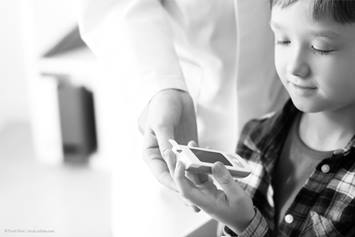Type 2 Diabetes
Type 2 diabetes is a chronic condition that occurs when your body makes insulin but does not know how to use it well.
What Is Type 2 Diabetes?
Our bodies are made up of many cells, and each cell needs sugar (glucose) for energy. Glucose comes from the food we eat. Insulin is a hormone that’s made in the pancreas. Insulin is the key that helps glucose get into cells and make energy.
Type 2 diabetes is a chronic condition that occurs when your body makes insulin but does not know how to use it well. This is called “insulin resistance.” If your body does not properly use insulin to keep your blood glucose at a normal level, the blood glucose rises: and diabetes results.
Type 2 diabetes is more common in adults, but children and teens can develop type 2 diabetes, too.
What Are the Signs and Symptoms of Type 2 Diabetes?
When blood glucose levels become high, some glucose leaves the body through urine. This causes many initial symptoms, which may include:
- Frequent urination
- Thirst
- Dry mouth
When your body cannot use glucose for energy, you may:
- Feel tired
- Lose weight
When glucose cannot get into the cells, your body starts to use fat for energy. When fat is used for energy, your body makes ketones.
When you have ketones in your blood, you may:
- Have a stomach ache
- Throw up (vomit)
Ketones are in the blood and urine and can cause blood to have more acid. Acid in the blood leads to diabetic ketoacidosis (DKA,) which can make you very sick. DKA is rare in type 2 diabetes but can still occur.
If you have diabetic ketoacidosis (DKA,) you may:
- Feel sick
- Start to breathe fast
- Have fruity smelling breath
- Have difficult waking up
- Experience confusion
What Causes Type 2 Diabetes?
Genetics and lifestyle play the largest role in type 2 diabetes.
- Type 2 diabetes can be If your mom or dad has type 2 diabetes, it doesn’t mean you’re guaranteed to develop type 2 diabetes: it just means you have a greater chance of developing it. Researchers are working to better understand what genetic mutations increase the risk of developing type 2 diabetes.
- Lifestyle plays a big role in type 2 diabetes, too. Your genes might make you more susceptible to type 2, but if you take good care of yourself, you may be less likely to develop it.
- Lack of exercise, unhealthy food choices and obesity can all play a role in developing type 2 diabetes.
How Is Type 2 Diabetes Diagnosed?
To diagnose diabetes, your doctor may order a glycated hemoglobin (A1C) test. Hemoglobin is a protein found in red blood cells. This blood test works by measuring the percentage of blood sugar attached to hemoglobin. The higher your blood sugar levels, the more hemoglobin with sugar attached. An A1C level of 6.5 percent or higher on two tests may indicate you have diabetes.
If your doctor does not order an A1C test, he or she may use a random blood sugar test, fasting blood sugar test or oral glucose tolerance test to diagnose diabetes.
If your test results show you have diabetes, your doctor may run additional tests to distinguish if you have type 1 or type 2 diabetes. These tests will check for autoantibodies that are common in type 1 diabetes. Ketones in your urine, though suggestive of type 1 diabetes, is sometimes seen in type 2 diabetes.
It may take many weeks for your doctor to confirm a diabetes diagnosis. It’s possible to have both type 1 and type 2 diabetes.
How Is Type 2 Diabetes Treated?
- Type 2 diabetes may be controlled by eating healthy foods, exercising every day and maintaining a healthy weight.
- Sometimes you may need pills to help your body use insulin better or get rid of extra glucose in the body.
- You may also need insulin.
Your care team will help you learn how to:
- Monitor your blood sugar levels
- Take insulin or medication (if needed)
- Eat a high-fiber, low fat diet
- Maintain a healthy exercise routine
Managing type 2 diabetes is very important. If high blood glucose is not treated adequately, glucose starts attaching to proteins in the body and causes organ dysfunction. This affects the eyes, kidneys, heart, blood vessels and nerves. The best way to completely prevent these problems is by keeping the blood glucose as normal as possible.
When Should You Seek Help for Type 2 Diabetes?
If you suspect your child has diabetes, talk to his or her pediatrician as soon as possible.
Having diabetes does not cause permanent problems, but high blood glucose over many years can cause permanent problems. That’s why managing diabetes is so important.
Diabetic Ketoacidosis (DKA) can be very dangerous. It is rare in type 2 diabetes but can still occur. If your child has DKA symptoms, contact your health care provider immediately or go to the emergency room.
Can Type 2 Diabetes be Prevented or Cured?
Currently, diabetes has no cure. But many researchers around the world are working hard to develop one.
If you’re at risk for type 2 diabetes, lifestyle changes can lower your chances of developing it. A healthy diet and exercise can help you avoid a type 2 diagnosis.
If you’re at high risk, your physician may recommend medications to help lower your chances of developing it.
Type 2 diabetes cannot be “reversed,” but some patients are able to go off medication with the right diet and exercise plan. Some may even be able to get their blood sugar levels back in the “prediabetes” range.



